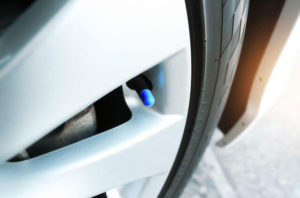If your RV tires run on nitrogen rather than regular air, you know it takes much longer for the psi level to drop. Still, the pressure will drop over time, and when that happens, you need to know how to refill your tires.
To fill your RV tires with nitrogen, you first need to purge the tires of all the air in the tire valve to eliminate any contaminated and moisture-filled air. Next, fill up the tire valve with pure nitrogen and seal it properly to prevent the tire from leaking.
In this article, I’ll cover all you need to know about using nitrogen in your RV tires instead of regular air, along with guidelines on how to do it.
Is Nitrogen a Good Option for RV Tires?
 Advantages of Nitrogen for RV Tires
Advantages of Nitrogen for RV Tires
When used in tires, nitrogen provides a number of notable advantages over ordinary air.
It’s More Stable
Compared to regular air, nitrogen has larger molecules that move more slowly inside the tire. This makes it more stable at various temperatures because it takes longer to heat up and cool down. Additionally, nitrogen-filled tires lose pressure far more slowly than ordinary air.
Slower Bleeding
Because of the absence of moisture and other pollutants in nitrogen, it can operate under cooler and more stable temperatures, which improves tire efficiency. The tires can hold their pressure for a lot longer because they don’t fluctuate in pressure relative to temperature changes.
Compared to regular air that leaks about 1.5 psi (10.34 kPa) per month, nitrogen-filled tires take a much longer four months to bleed the same amount of pressure. The absence of oxygen also prevents rusting of the rims, which occurs when oxidized air is used.
Also, according to this Get Nitrogen study, the consistency of the tire pressure improves the RV’s fuel efficiency. That’s because the tires are less likely to get worn out — which, in turn, puts less pressure on your engine to make your car work harder.
You Don’t Need Special Tires To Use Nitrogen
If you want to use nitrogen in your tires, you can do that without buying a new set of tires. Nitrogen works in tires the same way regular air does, and you can fill your tires with nitrogen like you would normal air. It’s also compatible with tire pressure monitoring systems (TPMS) and can be accurately monitored from the gauge cluster.
In case of an emergency leak for tires with nitrogen, you can always top off the nitrogen with regular air, and it will work just fine. When you can, get to a dealer and have all the air in the tire replaced with nitrogen.
 Disadvantages of Nitrogen for RV Tires
Disadvantages of Nitrogen for RV Tires
Despite all the above benefits, utilizing nitrogen has significant drawbacks as well.
More Expensive
Compared to regular air, nitrogen is substantially more expensive. Filling up one tire with nitrogen could cost anywhere from $3 to $10, depending on the size, pressure, and additional services provided by the dealer. Additionally, since you must fill the tires in 15-second intervals (more on this later), they take longer to fill.
Not Easily Available
It might be difficult to locate a dealer with nitrogen gas for your RV tires. If you can’t locate one, you can fill your tires with ordinary air until you find a nitrogen vendor. And even if you find a source of nitrogen for RV tires, you must ensure it’s pure enough to help with your tire’s efficiency.
How to Inflate your RV Tires with Nitrogen
1. Remove the Valve Caps

Some tires have hubcaps that close the tire valve. You must remove them for the tire to be purged or refilled with nitrogen; otherwise, you’ll risk having leftover contaminated gas. If your tire doesn’t have these, you can move on to the next step.
2. Inspect the Valve System for Leaks
Before refilling the tire, ensure that the valve that holds the nitrogen in the tube isn’t faulty. If you spot any leaks or other issues, have the valve system repaired before you refill the tire. Otherwise, the nitrogen will leak out after you refill the tire, rendering your efforts useless.
3. Purge the Tire of All Air, Then Refill It
Release all the air in the tire until it’s about three psi (20.7 kPa) of pressure. This is to maintain higher nitrogen purity after a refill.
After releasing the air from the tire, fill it with nitrogen to the manufacturer’s recommended psi level. Most manufacturers recommend around 35 psi (241.3 kPa) for car tires, while bigger vehicles will need more.
Use More Nitrogen for Worn-Out Tires
Using good quality tires enhances safety on the road — whether you’re using nitrogen or regular air. However, if your tires are worn out on the sides and you’re not in a position to replace them yet, it’s a good idea to fill them with an extra pound (0.45 kg) of nitrogen.
This forces the tire’s center closer to the pavement, increasing grip and improving ride quality. This also applies if you fill the tires in warm temperatures since the hotter air expands and may exaggerate the reading on the psi scale.
Additionally, extra nitrogen to the tires ensures the tires maintain enough pressure even during colder temperatures when the air volume has decreased.
4. Connect the Pressure Gauge to the Tire Valve.
Once the pressure gauge is connected to the tire valve, turn it on. I recommend that you fill the tire for 15 seconds at a time until you reach the necessary pressure level. The intervals give the system time to register the correct psi readings, so you’ll know that your vehicle is ready to go.
Related Articles:
– Can you plug RV Tires? Is It Safe?
– 8 simple steps to prevent dry rotting in RV tires
– Can you use car tires on rv trailer
Conclusion
Using nitrogen in your RV tires instead of regular air has several advantages, including longer tire life, better handling, and improved fuel economy. However, it also has disadvantages, such as greater cost and limited availability.
The process of refilling the tires with nitrogen is more or less the same as with regular air. If you have any problem following the procedure, feel free to ask for help from your nearest dealer.
